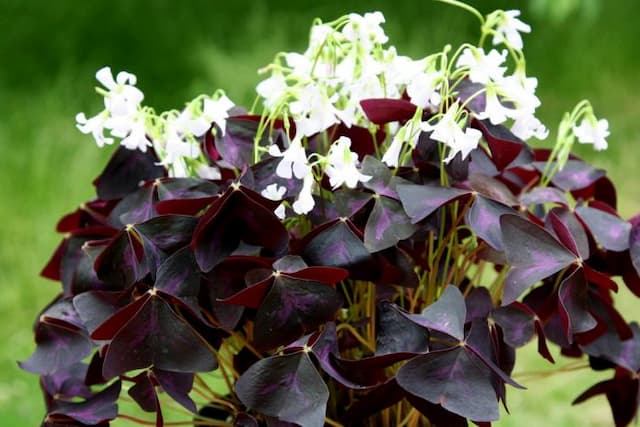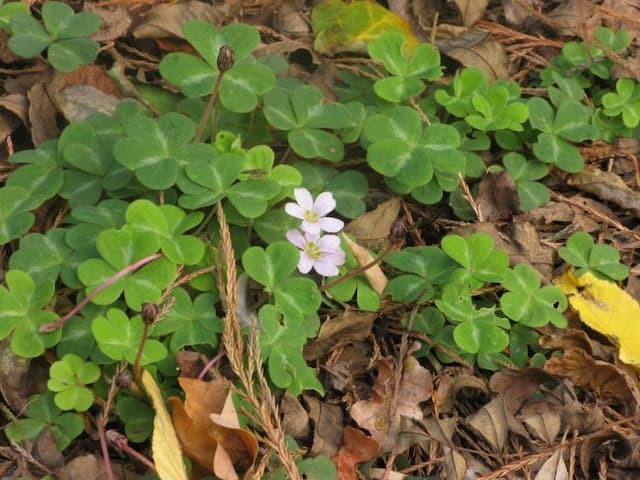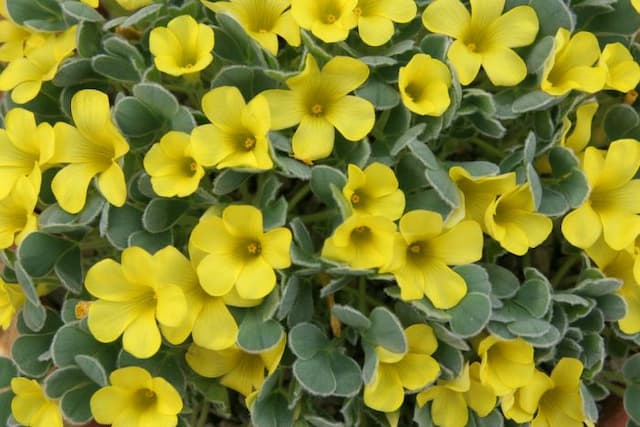False shamrock Oxalis perdicaria

ABOUT
Oxalis perdicaria, commonly known as Chilean oxalis, is an eye-catching flowering plant. The appearance of this plant is characterized by its trifoliate leaves, which means the leaves are divided into three heart-shaped leaflets, resembling a clover. Each leaflet is attached at the center to a slender petiole which is supportive stalk connecting them to the main stem. The leaves are bright green and can appear to have a slightly shiny or velvety texture. Chilean oxalis blooms produce an impressive display of flowers, mostly during the spring and summer seasons. The flowers are funnel-shaped and grow on the tips of long, thin flower stalks that arise from the central rosette of leaves. Each flower has five petals, which are typically bright yellow in color, with delicate veining that may be more noticeable upon closer inspection. The yellow flowers have a symmetrical arrangement and can add a splash of color to the area where the plant grows. After flowering, the plant may produce small, capsule-like fruits which contain the seeds for propagation. The overall appearance of Chilean oxalis is lush and vibrant, making it an attractive addition for garden beds, borders, or as ground cover. However, it's important to note that some members of the Oxalis genus are considered invasive in certain regions, so care should be taken to control its spread in gardens and natural areas.
About this plant
 Names
NamesFamily
Oxalidaceae.
Synonyms
Chilean Wood Sorrel, Chilean Oxalis, Perdicaria.
Common names
Oxalis fendleri, Oxalis latifolia, Oxalis magellanica, Oxalis sellowiana, Oxalis valdiviensis, Acetosella berteroana, Acetosella magellanica, Oxalis berteroana, Oxalis berteroana var. triangularis.
 Toxicity
ToxicityTo humans
Oxalis perdicaria, commonly known as sourgrass, contains oxalic acid and its salts, particularly in the form of oxalates. These substances can be toxic when consumed in significant quantities. The symptoms of oxalate poisoning in humans can include a burning sensation in the mouth and throat, difficulty swallowing, swelling of the throat leading to breathing difficulties, nausea, vomiting, diarrhea, abdominal pain, and renal failure in severe cases due to the formation of crystals in the urinary tract. It is recommended to avoid consuming large amounts of sourgrass or its extracts, and individuals with kidney disorders should be particularly cautious, as they may be more susceptible to the adverse effects of oxalates.
To pets
Oxalis perdicaria, commonly known as sourgrass, is toxic to pets, including dogs and cats, due to the presence of soluble oxalates. When a pet ingests a significant amount of sourgrass, the oxalates can bind with calcium in the body to form calcium oxalate crystals, potentially leading to hypocalcemia and resulting in symptoms such as drooling, nausea, vomiting, diarrhea, weakness, tremors, and renal failure. If pets consume enough sourgrass, these symptoms can escalate to potentially life-threatening conditions. It is imperative to prevent pets from ingesting sourgrass and to seek veterinary attention immediately if you suspect your pet has been poisoned by this plant.
 Characteristics
CharacteristicsLife cycle
Perennials
Foliage type
Deciduous
Color of leaves
Green
Flower color
Yellow
Height
0.5 feet (15 cm)
Spread
0.5 feet (15 cm)
Plant type
Herb
Hardiness zones
8
Native area
South America
Benefits
 General Benefits
General Benefits- Ornamental value: Oxalis perdicaria adds aesthetic appeal to gardens with its bright yellow flowers and clover-like leaves.
- Low maintenance: This plant is relatively easy to care for, requiring minimal attention once established in suitable conditions.
- Drought tolerance: It can withstand periods of dryness, which is useful in areas prone to water scarcity or for gardeners seeking water-efficient plants.
- Pollinator attraction: The flowers can attract bees and other pollinators, which are essential for the health of many ecosystems and the pollination of various plants.
- Edibility: Parts of the plant are edible, with a sour taste similar to lemongrass, and can be used in small amounts as a flavoring in salads and other dishes.
- Groundcover: As a low-growing plant, it can serve as an effective groundcover, helping to reduce soil erosion and suppress weed growth.
- Fast-growing: This characteristic allows for quick establishment and filling in of garden spaces, providing a lush appearance in a relatively short amount of time.
 Medical Properties
Medical Properties- Anti-inflammatory: Oxalis perdicaria may possess anti-inflammatory properties that could be useful for reducing inflammation.
- Antimicrobial: There might be compounds in Oxalis perdicaria that exhibit antimicrobial activity, helping to prevent or fight off bacterial infections.
- Analgesic: The plant has been reported to have analgesic properties, which might help alleviate pain.
- Hepatoprotective: Some studies might suggest that the plant has hepatoprotective effects, which could be beneficial for liver health.
- Antioxidant: Oxalis perdicaria could be a source of antioxidants, which help neutralize harmful free radicals in the body.
 Air-purifying Qualities
Air-purifying QualitiesThis plant is not specifically known for air purifying qualities.
 Other Uses
Other Uses- Oxalis perdicaria, also known as Chilean wood sorrel, can be used as a natural dye source; the pigments from its flowers have been traditionally used to create yellow or orange dyes.
- The plant's juice, due to its oxalic acid content, can be a cleaning agent for removing rust and stains from clothes and kitchenware.
- As a ground-cover plant, Chilean wood sorrel helps to stabilize soil and prevent erosion in garden landscapes or naturalized areas.
- The foliage can be a subtle flavoring agent in culinary creations, offering a lemony tang to salads or as a garnish for dishes.
- The plant's aesthetic beauty makes it an attractive choice for ornamental purposes in rock gardens and alpine garden designs.
- Due to its resilience, Chilean wood sorrel can be used in educational settings to teach children about plant growth and botany with minimal maintenance.
- The vibrant flowers can be pressed and used in the art of flower pressing, creating lasting decorative pieces or crafts.
- In a wildlife garden, it provides nectar for pollinators such as bees and butterflies, enhancing local biodiversity.
- Chilean wood sorrel's fast-spreading nature allows it to be used in greening projects where quick cover is needed on bare or denuded land.
- The plant can be used as an indicator species due to its sensitivity to both soil pH and metal contaminations, helping to monitor environmental quality.
Interesting Facts
 Feng Shui
Feng ShuiThe Oxalis is not used in Feng Shui practice.
 Zodiac Sign Compitability
Zodiac Sign CompitabilityThe Oxalis is not used in astrology practice.
 Plant Symbolism
Plant Symbolism- Luck - Oxalis perdicaria, also known as the "false shamrock" or "wood sorrel", is often associated with good fortune and luck, akin to the four-leaf clover due to its similarly shaped leaflets.
- Resilience - Its ability to thrive in various conditions and quickly regenerate after damage conveys a message of resilience and adaptability.
- Joy - The delicate, typically pink flowers of Oxalis perdicaria can symbolize joy and delight, often blooming even in the cooler temperatures of late winter or early spring.
- Balance - The trifoliate (three-part) leaves are believed to represent balance and harmony in life, reflecting the plant's balanced growth habit.
 Water
WaterThe plant commonly known as Chilean oxalis or oxalis should be watered when the top inch of the soil feels dry. Depending on the environment, this usually equates to watering once a week with about 8-12 ounces of water for a potted plant. The exact amount may vary based on factors like temperature and humidity. During the dormant period in summer, reduce watering, allowing the soil to dry out completely before watering again.
 Light
LightChilean oxalis thrives in bright, indirect light but can tolerate partial shade. Avoid placing this plant in direct sunlight, which can scorch the leaves. A north-facing or east-facing window would be ideal, providing plenty of light without the intensity of direct afternoon sun.
 Temperature
TemperatureChilean oxalis does well in a temperature range of 50 to 75 degrees Fahrenheit. It can survive temperatures as low as 30 degrees Fahrenheit but is best protected from frost. The ideal temperature for promoting growth and flowering is within the comfortable room temperature range.
 Pruning
PruningPruning Chilean oxalis is minimal and is mostly done to remove spent flowers or yellowed foliage. This encourages new growth and enhances the plant's appearance. The best time to prune is after flowering or when you notice dead or damaged leaves.
 Cleaning
CleaningAs needed
 Soil
SoilFor Chilean oxalis or Oxalis perdicaria, the ideal soil mix is well-draining soil with organic matter like peat or compost. A mixture containing two parts peat or garden soil to one part sand or perlite is beneficial. Maintain a soil pH of around 6.0 to 7.5.
 Repotting
RepottingChilean oxalis, or Oxalis perdicaria, should be repotted every 2-3 years to refresh the soil and accommodate growth. Best done in the spring as new growth begins.
 Humidity & Misting
Humidity & MistingChilean oxalis, or Oxalis perdicaria, thrives in moderate humidity levels around 40-50%. Avoid extremely dry or highly humid environments for optimal health.
 Suitable locations
Suitable locationsIndoor
Place Chilean oxalis in bright, indirect light indoors and ensure well-drained soil.
Outdoor
Grow Chilean oxalis in partial shade or morning sun; protect from hot afternoon rays.
Hardiness zone
7-10 USDA
 Life cycle
Life cycleOxalis perdicaria, commonly known as Chilean woodsorrel, begins its life cycle as a seed that germinates in favorable conditions, which typically include moist, well-drained soil and partial shade. Upon germination, the seedling emerges and develops into a young plant with characteristic heart-shaped or clover-like leaves. As the plant matures, it begins to flower, producing yellow flowers that can contribute to its propagation through pollination by insects. After flowering, the plant produces fruits, which are small capsules containing seeds that, when mature, are dispersed by various means such as wind, water, and animal activity. The plant then enters a period of dormancy, especially in colder climates or during dry seasons, where it conserves energy and resources to survive adverse conditions. With the return of favorable circumstances, the plant resumes growth, completing the cycle, and may also spread vegetatively through its bulbils and rhizomes.
 Propogation
PropogationPropogation time
Spring-Early Summer
Propogation: Oxalis perdicaria, commonly known as Chilean oxalis or golden oxalis, is typically propagated by dividing the bulbils or small bulbs that form around the main bulb of the plant. The best time to do this is when the plant is dormant which usually occurs in late summer to early fall. The process involves carefully digging up the plant, separating the small bulbs from the main one, and planting them in well-draining soil at a depth of about 1 to 2 inches (2.5 to 5 centimeters), ensuring they have enough space to grow. It is important to water the new plantings adequately and place them in a location where they can receive full to partial sunlight. With the right care, these bulbils will develop into new plants that mirror the characteristics of the parent Chilean oxalis.




